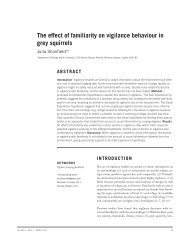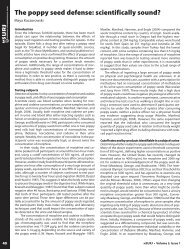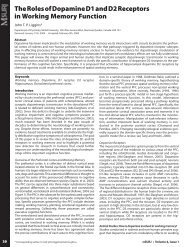the entire issue - McGill Science Undergraduate Research Journal ...
the entire issue - McGill Science Undergraduate Research Journal ...
the entire issue - McGill Science Undergraduate Research Journal ...
You also want an ePaper? Increase the reach of your titles
YUMPU automatically turns print PDFs into web optimized ePapers that Google loves.
Neuronal spiking is better than bursting at predicting motion detection in area MT<br />
Fig. 5<br />
This bar graph depicts <strong>the</strong> average number of bursts per correct<br />
trial and incorrect trial. As our obtained p-value was much smaller<br />
than 0.01, <strong>the</strong> plotted error bars are difficult to see.<br />
Fig. 6<br />
This bar graph depicts <strong>the</strong> average number of bursts per correct<br />
trial and incorrect trial for <strong>the</strong> 5 experiments with 80% coherence in<br />
receptive field 1 and 2, p < 0.01.<br />
As a post-hoc analysis, we wanted to see if <strong>the</strong> percentage of coherence<br />
in <strong>the</strong> RDP would alter our results. Of all 50 experiments, we<br />
found five experiments that represent <strong>the</strong> highest level of coherence:<br />
80% coherent motion in both receptive field 1 and receptive field 2.<br />
When we ran our analysis again only for <strong>the</strong>se five experiments, we<br />
found that <strong>the</strong> aROC values were higher in general. However, <strong>the</strong> best<br />
bursting parameters remained <strong>the</strong> same: 1 spike/10ms had an aROC<br />
value of 0.6715, 1 spike/20 ms had an aROC value of 0.6503, and 2<br />
spikes/20 ms had an aROC value of 0.6454.<br />
We calculated <strong>the</strong> average number of bursts only for <strong>the</strong> five experiments<br />
that had 80% coherence in <strong>the</strong> two receptive fields for<br />
<strong>the</strong> bursting parameter 2 spikes/20 ms (Fig. 6). We found <strong>the</strong> average<br />
number of bursts for correct trials to be 1.3317, and <strong>the</strong> average<br />
number of bursts for incorrect trials to be 1.0390 (p < 0.01).<br />
2) aROC value for Isolated Spiking Activity<br />
When <strong>the</strong> “detect probability” function was run for isolated spikes<br />
and averaged over neuron 1 and neuron 2 of all experiments, we<br />
obtained an average aROC value of 0.5961. We conducted <strong>the</strong> same<br />
post-hoc analysis (as described in section 1 of results) for <strong>the</strong> five<br />
experiments with 80% coherence in both receptive fields, and found<br />
an aROC value of 0.7163.<br />
Discussions<br />
After creating a matrix with different bursting parameters, we found<br />
<strong>the</strong> highest aROC values for 1 spike/10 ms, 1 spike/20 ms, and 2<br />
spikes/20 ms. This suggests that <strong>the</strong>se bursting parameters have <strong>the</strong><br />
highest predictability of behaviour. The aROC values we obtained for<br />
2 spikes/20 ms and for average spiking under Condition 1 are 0.5666<br />
and 0.5691, respectively. Since both can be rounded to 0.57, <strong>the</strong> difference<br />
between spiking and bursting in Condition 1 is not significant.<br />
For <strong>the</strong> bursting parameter 2 spikes/20 ms, we found <strong>the</strong> average<br />
number of bursts for correct trials to be 1.6371, and <strong>the</strong> average<br />
number of bursts for incorrect trials to be 1.2537 (p < 0.01), asserting<br />
that <strong>the</strong>re is a significant difference in neuronal bursting between<br />
correct trials and incorrect trials.<br />
In order to determine if <strong>the</strong> percentage of motion coherence in <strong>the</strong><br />
RDP played a role in our results, we analyzed <strong>the</strong> experiments that<br />
presented 80% coherence (<strong>the</strong> maximum coherence across all experiments)<br />
in both receptive fields. We found five experiments that<br />
42<br />
<strong>McGill</strong> <strong>Science</strong> <strong>Undergraduate</strong> <strong>Research</strong> <strong>Journal</strong> - msurj.mcgill.ca









